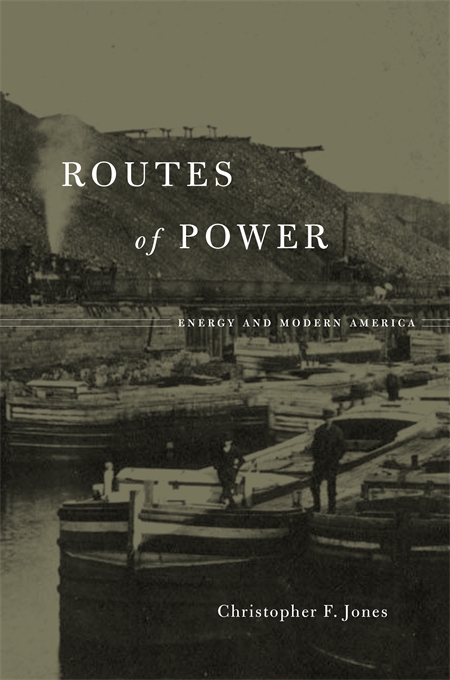Jones, Christopher F. Routes of Power: Energy and Modern America. Harvard University Press, 2014.
 Routes of Power is a book about the way energy travels and the consequences of its pathways on how we use it and think (or not) about it. Its principal innovation is in its focus on the efforts to build a transport infrastructure enabling coal, oil, and electricity to travel to distant markets. While grounded in the mid-Atlantic region of the United States between 1820 and 1930, this books speaks to a larger question of the transition from an organic to a mineral regime and to the concomitant changes in energy consumption patterns.
Routes of Power is a book about the way energy travels and the consequences of its pathways on how we use it and think (or not) about it. Its principal innovation is in its focus on the efforts to build a transport infrastructure enabling coal, oil, and electricity to travel to distant markets. While grounded in the mid-Atlantic region of the United States between 1820 and 1930, this books speaks to a larger question of the transition from an organic to a mineral regime and to the concomitant changes in energy consumption patterns.
Jones’ book is an excellent tool for thinking with history about our present energy challenges for three reasons. First, by developing the notion of landscapes of intensification, this book speaks about both winners and losers of the transition. While New York and Philadelphia could enjoy better and cheaper artificial lighting, the residents of western Pennsylvania’s oil regions lived awash in spilled oil and inhaled air burdened with gas and soot. For example, in Titusville, PA in the 1860s, clean water was more expensive than oil. In 1879, in one month alone, western Pennsylvanian oil men spilled the equivalent of the crude spilled in the 1989 Exxon Valdez disaster approximately 240,000 barrels.
Second, by emphasizing social dimensions of energy transition, Jones reminds us that any shift in energy use amounts to more than just a set of substitution of fuels. Historically, the move from organic to mineral energy sources in the United States changed not only how humans related to the environment but also how they related to each other. Hence, if history is any indication, it is foolish to think that we can simply replace coal-fired power plants with wind turbines and expect everything else to remain the same. Jones issues a gentle but stern warning: the pressing task is to wrap our minds around profound lifestyle changes if we are to weather the present crisis. The problem is not simply about finding alternative sources to satisfy our current consumption levels; it is about embracing changes that will enable us to decrease them.
Third, Jones shows that the shift from organic to mineral regime was fueled by supply, not the demand. To engineer new energy behaviors, mid-Atlantic boosters had to labor for decades to create a demand for mineral fuels. The present challenge is the opposite—reducing demand—but the lesson from the past is valuable: demand is not static. Just as in the hundred years between 1850 and 1950 we learned to live as though energy was abundant, cheap, and came with little risk, we can unlearn some of those habits and create new ones.
Aleksandra Kobiljski, Ecole des hautes études en sciences sociales (EHESS)
![[Teach311 + COVID-19] Collective](https://blogs.ntu.edu.sg/teach311/files/2020/04/Banner.jpg)